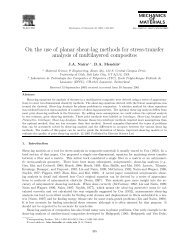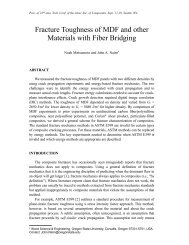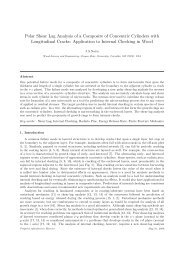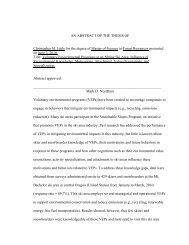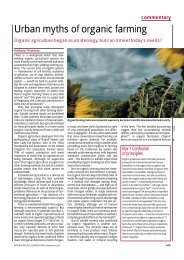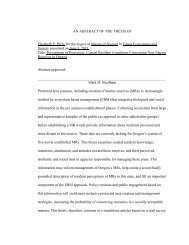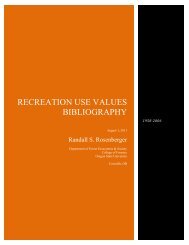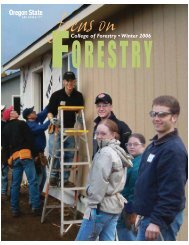College of Forestry - Oregon State University
College of Forestry - Oregon State University
College of Forestry - Oregon State University
You also want an ePaper? Increase the reach of your titles
YUMPU automatically turns print PDFs into web optimized ePapers that Google loves.
From the Dean<br />
Educating future scientists,<br />
natural resource managers, policy<br />
makers, and industry leaders is a key<br />
assignment for our faculty. With 634<br />
students enrolled, we are continuing<br />
a 6-year growth trend that has us<br />
hitting our highest student numbers<br />
in 25 years. These students represent<br />
most states in the Union and countries<br />
from all corners <strong>of</strong> the world.<br />
Natural resources enrollment around<br />
the nation is declining, so our growth<br />
reflects the strength <strong>of</strong> our instructors<br />
and programs. Locking away our natural<br />
resources won’t satisfy the diverse<br />
demands <strong>of</strong> our populace—trained<br />
pr<strong>of</strong>essionals are necessary to help<br />
protect, manage, and optimize the<br />
uses for forest lands and forest products.<br />
We are producing skilled graduates<br />
who are in demand by private<br />
and public employers. The ever-rising<br />
cost <strong>of</strong> education challenges many <strong>of</strong><br />
these students and their families, but<br />
the generosity <strong>of</strong> <strong>Forestry</strong>’s supporters<br />
helped to provide over $600,000 in<br />
scholarships and fellowships in 2006.<br />
This helps attract and retain excellent<br />
students who might otherwise forego<br />
an education.<br />
The second key assignment for<br />
our faculty is conducting research,<br />
developing new knowledge, and transferring<br />
what we’ve learned to other<br />
scientists, the public, industry, and<br />
governmental leaders. The breadth <strong>of</strong><br />
research conducted by our scientists<br />
is amazing and goes far beyond the<br />
stereotypical concepts <strong>of</strong> forestry.<br />
They utilize leading-edge techniques<br />
and knowledge to study watershed<br />
and water quality issues, fiber-based<br />
composite engineering, tree genetics<br />
and growth, carbon sequestration<br />
and climate, fish and wildlife habitat,<br />
maximization <strong>of</strong> economic value <strong>of</strong><br />
logs and lumber production, forest<br />
health, and fire prevention and<br />
restoration. Declining support in<br />
appropriated funding has left us with<br />
faculty vacancies in essential areas<br />
such as soil chemistry and nutrition,<br />
wildlife protection, and structural engineering.<br />
Our hard-working faculty<br />
did achieve a record $13.1 million in<br />
outside grants and contracts for the<br />
year. This is a tremendous testament<br />
to their productivity. It means that<br />
for every dollar <strong>of</strong> state appropriation<br />
provided to support the basic salary<br />
and infrastructure for FRL research,<br />
the faculty bring in over five dollars<br />
worth <strong>of</strong> additional research productivity.<br />
This is a direct return on investment<br />
that adds to <strong>Oregon</strong>’s economy<br />
and multiplies the amount <strong>of</strong> natural<br />
resources-related research and knowledge<br />
available to <strong>Oregon</strong>ians.<br />
I’m truly proud to say that the<br />
efforts <strong>of</strong> our scientists and students<br />
recently earned OSU a Number 1<br />
ranking for forestry research in North<br />
America. This annual report provides<br />
some highlights <strong>of</strong> those efforts. I<br />
must add that we did not earn a Number<br />
1 by ourselves. We did it through<br />
extensive collaboration with colleagues<br />
across campus, in the Forest<br />
Service, EPA, and USGS labs in Corvallis,<br />
and in state and federal agencies,<br />
other universities, conservation<br />
groups, and forest industry across the<br />
state, nation, and world. I must also<br />
add that earning Number 1 does not<br />
happen overnight. It takes a continuous<br />
commitment by all stakeholders,<br />
both inside and outside OSU. We’ve<br />
had this commitment to provide <strong>Oregon</strong>ians<br />
with multi-use, multi-benefit<br />
forest lands and a vibrant forest<br />
products sector for 100 years. I look at<br />
this as a foundation for supporting a<br />
dynamic Future <strong>of</strong> Possibilities.<br />
1940<br />
Earl G. Mason is appointed<br />
acting dean.<br />
1941<br />
<strong>Oregon</strong> Forest Products<br />
Laboratory is created in<br />
cooperation with School<br />
<strong>of</strong> <strong>Forestry</strong>.<br />
1942<br />
Paul M. Dunn is appointed<br />
dean.<br />
1944<br />
Dan Robinson is hired as<br />
first Extension Forester.<br />
1953<br />
<strong>Oregon</strong> Legislature establishes Forest<br />
Protection and Conservation Committee.





